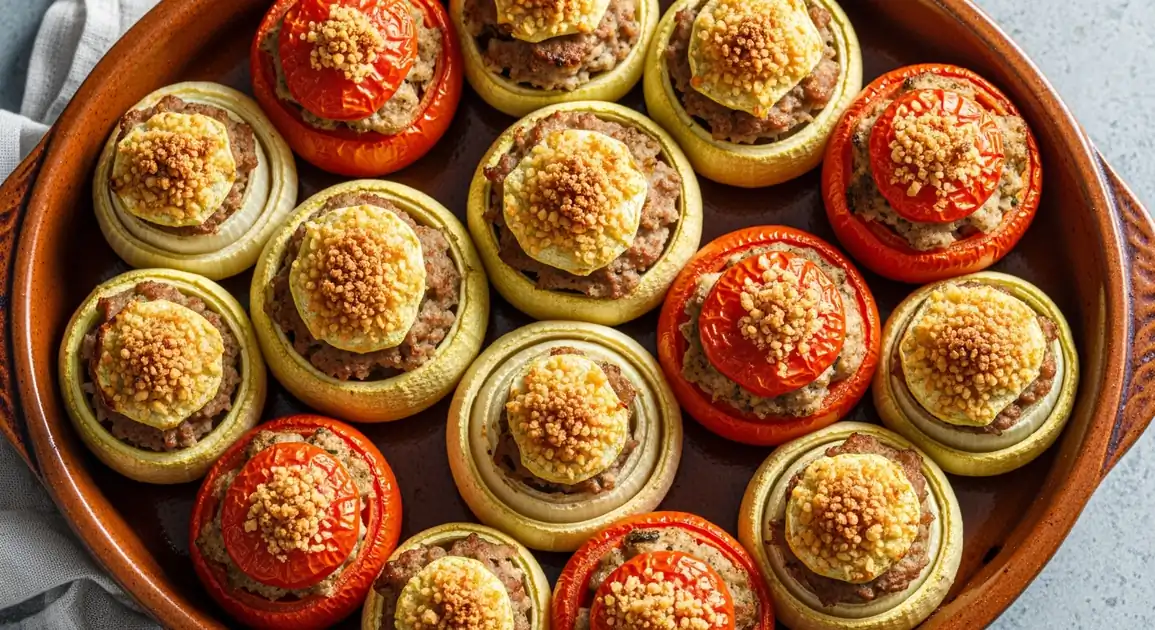Farcis Niçois (Niçoise Stuffed Vegetables)
Farcis Niçois (Les Petits Farcis)

Description
In Nice, 'Les Petits Farcis' are omnipresent and iconic. From the vibrant stalls of the Cours Saleya market to neighborhood 'boulangerie-traiteurs' and traditional restaurants in Vieux Nice, they are a readily available taste of local culinary heritage. They perfectly capture the essence of Niçoise cuisine: fresh, seasonal, and flavorful.
Dietary Information
Serving information
Serving style
Most often sold by the piece at room temperature from markets/traiteurs. Restaurants typically serve an assortment of 3-4 pieces, often lukewarm or slightly warmed, plated as a starter.
Quick facts
Markets: Primarily mornings (~8 AM - 1 PM). Bakeries/Traiteurs: Generally daytime hours (~8 AM - 7 PM). Restaurants: Lunch (12 PM - 2 PM), Dinner (7 PM onwards).
Safety Tips
What to Look For
-
Purchased from a reputable source (busy market stall, clean traiteur, good restaurant)
Ensures better hygiene standards and likely fresher ingredients.
-
Vegetables and filling look fresh and vibrant
Avoid items that look wilted, dried out, discolored, or have been sitting for a very long time, especially if at room temperature.
-
High turnover at vendor stalls
Especially important for food served at room temperature. Busy stalls mean the food is likely prepared more recently.
-
Served properly hot if ordered in a restaurant setting
If meant to be served hot, it should arrive steaming or very warm.
What to avoid
-
Farcis that look old, dried out, or greasy
Suggests they have been sitting too long or were poorly prepared.
-
Vendors with questionable hygiene practices or unclean displays
Increases the risk of contamination.
-
Buying large quantities late in the day from market stalls
Freshness might be compromised compared to earlier in the day when items are freshly made.
-
Farcis left uncovered and exposed for long periods
Increases risk of contamination from dust, insects, or handling.
Price information
Price range
Budget tips
- Best prices per piece are usually found at market stalls (Cours Saleya, Libération market) or local traiteurs away from the main tourist drags (€2-€3.50).
- Restaurant starters featuring 3-4 farcis will cost significantly more (€10-€16).
- Buying an assortment ('un assortiment') can sometimes offer slightly better value per piece.
Value indicators
- Looks freshly made (check turnover at stalls).
- Good balance of stuffing vs vegetable.
- Vibrant colors, not faded or dried.
- 'Fait Maison' sign or vendor reputation (e.g., specific stalls known for quality).
Where to Find This Dish
Cours Saleya Market
Numerous stalls sell various types of farcis, especially in the food section. Quality varies, observe freshness.
Flower Market / Food Market area
Morning (Tue-Sun)
Vieux Nice (Old Town)
Many traditional restaurants and some dedicated traiteur shops offer farcis.
Rue Pairolière, Place Rossetti
Lunch, Dinner (restaurants), Daytime (traiteurs)
Libération Market
Large local market with potentially better prices and authentic vendors in the food hall / surrounding stalls.
Gare du Sud, Avenue Malausséna
Morning (Tue-Sun)
Local Boulangeries/Traiteurs
Found in bakeries across various neighborhoods (e.g., Musicians, Port, Cimiez).
Neighborhood streets
Lunchtime
Vendor Tips
- Compare appearance and apparent freshness between different market stalls before buying.
- Look for the 'Cuisine Nissarde' label in restaurants for guaranteed traditional recipes.
- Ask locals for recommendations on their favorite place for farcis.
- Be specific about wanting meat ('viande') or meatless ('au maigre') versions.
How to Order
Regional Variations
-
Emphasis on 'Courgette Ronde de Nice'
(Emphasis on 'Courgette Ronde de Nice')
Using the local variety of small, round zucchini is considered most authentic.
-
'Farcis au Riz'
('Farcis au Riz')
While less common than breadcrumb stuffing, some variations use rice in the filling, especially in meatless versions.
-
Use of 'Blette' (Swiss Chard)
(Utilisation de la Blette)
Finely chopped Swiss chard is a very common ingredient in the stuffing, both meat and meatless versions, in Nice.
Cultural context
History
Rooted in the frugal and resourceful cooking traditions of Provence, 'farcis' were a way to utilize leftover meat and bread along with the abundant summer vegetable harvest. Each family often had its own variation. The dish became a staple in Niçoise homes, markets, and restaurants, celebrating the region's fresh produce and Mediterranean flavors.
Local significance
A true symbol of Nice's culinary identity ('Nissarde'). Represents the heart of home-style cooking using local summer produce.
Eating customs
- Enjoyed casually, often as part of a selection of Niçoise specialties (like Pissaladière, Salade Niçoise).
- Eating at room temperature is perfectly normal and traditional.